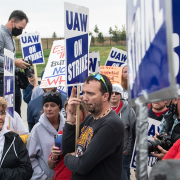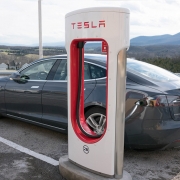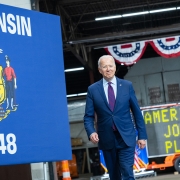Trump is Fighting an American Class War – and Winning
The most important political event this week will not be the upcoming GOP debate but Donald Trump’s expected visit with striking UAW workers as the walkout expands to other states. In that one appearance, Trump demonstrates one of the most critical parts of political change, the emergence of the populist right.
The fact that Trump can expect something of a friendly reception is remarkable. He’s the child of wealth who revels in luxury and whose prime cause seems to be tax cuts for his fellows. But he fuels his campaign on the anger of America’s middle and working classes. In 2016, exit polls showed a larger share of union households voted for Trump than any president since Ronald Reagan. In 2020 in Ohio, he received roughly half the votes of unionized construction workers.
Once hostile to unions, Republicans like Florida’s Senator Marco Rubio, Ohio’s JD Vance and Missouri’s Josh Hawley have all pledged support to the strikers. Union-affiliated Democrats may find this “laughable,” but perhaps not so amusing on election day. Certainly, Biden is doing his best to expand his working-class base.
In its first two years, the Biden administration ushered in high levels of inflation that has eroded as much as $7,000 in average purchasing power. The Biden record is further scarred by expanding inequality, home affordability at a near an all-time low and poverty, particularly among, children on the rise. One recent poll found that nearly 70 percent of Americans think the economy is worse now than in 2020.
This distress is reflected, among other things, in a rapid rise in strikes, up 50 percent over the past year. Faced with assaults on their jobs, much of the working class is not marching in sync with the Democrats’ “net zero” agenda. They realize that the much hyped green jobs – a recent study found barely one percent of workers in “dirty” jobs find jobs in “clean” sectors – are likely to be fewer in numbers and lower in quality than those jobs which will be lost.
The auto strike illustrates the dangers of Biden’s bid to rapidly transform a massive $3 trillion global industry. EVs require the use of 30 percent less domestic labor in the U.S. as high value employment shifts to China and other overseas spots; in Germany job losses could reach upwards of 400,000 of its estimated 800,000 auto jobs by 2030. The clear big winner is China which now produces twice as many EVs as the US and the EU combined.
Detroit brass may make ever higher salaries but everyone else has their head on the proverbial chopping block. Ford recently announced massive layoffs for its professional staff, and is losing $60,000 per EV, something not exactly sustainable. Worse yet, most new electric vehicle and battery plants are located either in the Heartland, the South or other non-union locations. UAW demands for a 30 per cent pay rise over four years and a 32 hour work week won’t make automakers more anxious to go union.
The EV mandate also constitutes a slap in the face of middle- and lower-income people who have never been inside an auto plant. The average price for a brand-new EV is over $60,000, about $12,000 more than the average four-door sedan. The electric version of the Ford F-150 pickup truck, the best-selling vehicle in America, costs an additional $26,000 over the gasoline-powered variety. Some two-thirds of all EV owners have incomes in excess of $100,000.
The rest will be forced a la Cuba into holding onto their own vehicles for additional decades or give up owning their own cars entirely. Even the Washington Post recently admitted that electric vehicles are hastening the return to conditions where the automobile becomes once again a luxury.
“New cars, once part of the American Dream, now out of reach for many,” notes the voice of Bezos.
Nor is the green assault likely to impact only autoworkers and consumers. Workers involved in energy-intensive industries like food, logistics and construction all face massive green regulatory onslaughts. All this reflects what seems an almost purposeful diminishing of the American dream, with the EV the latest poster child for the new green class order. US treasury secretary Janet Yellen recently suggested that her department sees climate change as ‘the greatest economic opportunity of our time’. To be sure, there’s lots of gold in green for the same Wall Street investors, tech oligarchs and inheritors who fund the campaigns of climate activists.
But for the hoi polloi, as Trump will remind them, there is little prospect for a full-bore industrial revival under the Biden regulatory regime. Despite all the subsidies being provided by Biden to US industries, American manufacturing has dropped recently to its lowest point since the pandemic. Blue collar workers like truck drivers, farmers, miners and oil rig workers have already been shifting to the GOP. For these workers the promise of “net-zero” and “degrowth” raises the prospect of unemployment and a future on the dole. Just one per cent of blue collar workers, according to a new Monmouth poll, consider climate as their main concern.
For Trump and the GOP, seizing on these working class concerns is all the more important as the antics of the former President and his coterie will continue to cost votes among better educated voters. Perhaps most critical will be attempts to win over minorities who make up over 40 percent of the nation’s working class and will constitute the majority by 2032. These workers – the very minorities Democrats have counted on to assure their future ascendancy – are feeling abandoned by the party, notes long-time Democratic analyst Ruy Teixeira, coauthor of the upcoming book, “Where Have the Democrats Gone?”
Teixiera points also to cultural issues to explain the shift of minority voters towards both Trump and the Republicans. Many minority parents tend to be leery of transgender transitions for under age youths and in California. Recent immigrants, African Americans and Muslims have been in the forefront of protests against new sex education standards, with graphic representations of carnal acts of various kinds. Overall, immigrants – according to one recent survey – are twice as conservative in their social views as the general public.
Of course, the transformation of the GOP into a working-class party, much less a more diverse one, is far from assured. Much of the party’s power base cares far more about achieving outsized profits than improving conditions for their workers, or anyone else. Tax cuts for the ultra-rich, lower capital gains, attempts to overturn Obamacare, draconian abortion bans – all part of the Republican program – are not winners with working- or middle-class voters.
Faced with a close race, Biden may follow the lead of some European leaders in slowing and even reversing some of his ultra-green policies. As the greens lose support, political leaders in places like Germany – suffering Europe’s highest energy prices and EV-driven layoffs – are rethinking their rapid “net zero” approach; this reassessment is going on as well in struggling economies like Italy and Poland, and the United Kingdom. Even Labour, once uniformly ultra-green, seems to have second thoughts about the net zero agenda’s impact on union jobs.
The auto strike, and Trump’s bold attempt to take advantage of it, reveals how much working class voters now see the Democratic Party, as insurgent Robert F Kennedy junior has suggested, as the party of corporate power, political censorship and cultural extremism. Their real interests may not align with Trump’s, but until Democrats rediscovers their popular roots, we will have to consider the horrid prospect of his return to the White House.
This piece first appeared at Telegraph.
Joel Kotkin is the author of The Coming of Neo-Feudalism: A Warning to the Global Middle Class. He is the Roger Hobbs Presidential Fellow in Urban Futures at Chapman University and Executive Director for Urban Reform Institute. Learn more at joelkotkin.com and follow him on Twitter @joelkotkin.
Photo: USDA via Flickr under CC 1.0 License.





 Official White House photo
Official White House photo D. Ramey Logan, used under CC 3.0 License
D. Ramey Logan, used under CC 3.0 License

